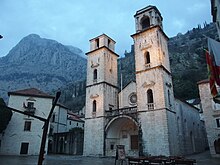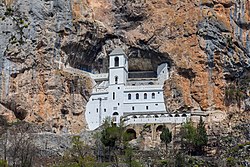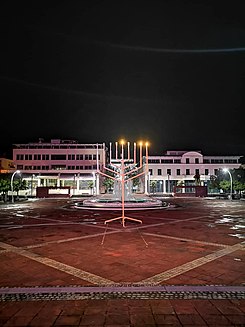Religion in Montenegro (2023 census)[1]

Eastern Orthodox Christianity is the largest religion in Montenegro at 71% of the population, and is the religion of choice for the vast majority of ethnic Montenegrins and Serbs. In addition to Eastern Orthodox Christianity, there is also a sizeable number of adherents to Sunni Islam at 20% of the population, mainly from ethnic Bosniaks and Albanians.
The majority of Eastern Orthodox Christians in the country belong to the canonically recognized Serbian Orthodox Church, but a small minority adhere to the Montenegrin Orthodox Church, which is not canonically recognized by the Eastern Orthodox Church. According to a 2020 poll conducted by CEDEM, approximately 10% of Montenegro's Eastern Orthodox Christians have opted for the Montenegrin Orthodox Church, while approximately 90% have opted for or stayed with the Serbian Orthodox Church.[2]
Demographics
[edit]Historical demographics
[edit]| 1953 | 1991 | 2003 | 2011 | 2023 | |
|---|---|---|---|---|---|
| Eastern Orthodox | 45.84 | 69.12 | 74.23 | 72.07 | 71.10 |
| Islam | 17.65 | 19.18 | 17.74 | 19.11 | 19.99 |
| Roman Catholic | 4.81 | 4.41 | 3.54 | 3.44 | 3.27 |
| Protestant | no data | 1.41 | 0.39 | 0.44 | 0.09 |
| Irreligious / Atheist | 31.46 | 1.6 | 0.96 | 1.24 | 2.29 |
| Agnostic | 0.07 | 0.40 | |||
| Undeclared | 0.01 | 0.02 | 2.23 | 2.61 | 2.10 |
| Other religions | 0.03 | 0.17 | 0.07 | 1.02 | 0.09 |
| Unknown | no data | 4.03 | 0.8 | no data | 0.16 |
Distribution by ethnic group in 2011
[edit]The results of the Montenegrin census of 2011 by ethnic groups, the latest census in which the indication of identification (whether by confession or as irreligious) in the question for confession was obligatory, are as follows:
| Ethnic groups by confession |
Total | Montenegrins | Serbs | Bosniaks | Albanians | Roma | Croats | |||||||
|---|---|---|---|---|---|---|---|---|---|---|---|---|---|---|
| Number | % | Number | % | Number | % | Number | % | Number | % | Number | % | Number | % | |
| Eastern Orthodox | 446,858 | 72.1 | 248,523 | 88.7 | 177,091 | 99.4 | 19 | 0.03 | 37 | 0.1 | 516 | 8.2 | 90 | 1.5 |
| Islam | 118,477 | 19.1 | 12,931 | 4.6 | 79 | 0.04 | 74,343 | 99.7 | 22,267 | 73.1 | 5,034 | 80.5 | 3 | 0.0 |
| Catholic | 21,299 | 3.4 | 5,667 | 2.0 | 116 | 0.06 | 3 | 0.0 | 7,954 | 26.1 | 13 | 0.2 | 5,527 | 91.8 |
| Protestantism | 1,601 | 0.4 | 921 | 0.3 | 262 | 0.15 | 36 | 0.1 | 2 | 0.0 | 2 | 0.0 | ||
| Atheism/Agnosticism | 9,005 | 1.3 | 6,393 | 2.3 | 697 | 0.39 | 108 | 0.1 | 150 | 0.4 | 1 | 0.0 | 224 | 3.7 |
Christianity
[edit]
Eastern Orthodoxy
[edit]Eastern Orthodox Christianity is the dominant religion in Montenegro with 443,394 believers, which comprise 71.1% of the population.[4] Adherents of Eastern Orthodoxy in Montenegro are predominantly ethnic Montenegrins and Serbs. Most ethnic Montenegrins and Serbs are adherents of the Serbian Orthodox Church and its dioceses in Montenegro: Metropolitanate of Montenegro and the Littoral, Eparchy of Budimlja and Nikšić, parts of Eparchy of Mileševa, and parts of Eparchy of Zahumlje and Herzegovina.[5] Ethnic Montenegrins are divided between the Serbian Orthodox Church and the Montenegrin Orthodox Church, which is considered by the Serbian Orthodox Church and the other autocephalous Orthodox Churches as a non-canonical schismatic, heretical, and a political fabrication Orthodox church.[6]
Catholic Church
[edit]Most Catholics are ethnic Albanians and Croats as well as some Montenegrins.
Islam
[edit]Muslims form the largest minority religion in the country. In 2023, Montenegro's 124,668 Muslims made up 19.99% of the total population.[1]
Muslims in Montenegro are divided into two main groups, and further subgroups:
- Bosnian-speaking ethnic Bosniak Muslim
- Other Slavic Muslims (ethnic Muslims), including Gorani, and other Slavs of the Muslim faith who identify by religion rather than by ethnicity.
- Albanian Muslims
- Albanian-speaking ethnic Albanian Muslims
- Romani people
Islam is the dominant religion in the northeastern municipalities, which are part of the Sandžak geographical region, and in municipalities where Albanians form a majority. Islam is the majority religion in the municipalities of Gusinje, Petnjica, Plav, Rožaje, Tuzi and Ulcinj.
Judaism
[edit]
According to the World Jewish Congress, there were approximately 400 to 500 Jews in the country in 2022.[7] There is a high respect for the Jewish people and its contribution to the secular civilization.[8] In February 2012, the Prime Minister of Montenegro Igor Lukšić signed an agreement with the Montenegrin Jewish community to grant official recognition of Jews as a minority in Montenegro. The agreement also established Judaism as the country's fourth official religion, along with the Eastern Orthodox Church, Catholic Church and Islam.[9]
Atheism
[edit]The majority of Montenegro's population, 98.69%, declares to belong to a religion, though observance of their declared religion may vary widely.
On the census from 2011, atheists, those who declared no religion, comprised about 1.24% of the whole population, and agnostics 0.07%.
Religiosity is lowest in the Bay of Kotor region and the capital city of Podgorica. Municipalities with highest share of atheists are Herceg Novi (2.43%), Kotor (2.03%), Podgorica (1.99%) and Tivat (1.7%). In contrast, Rožaje has the fewest atheists, who make up only 0.01% of its population.[10]
Religious freedom
[edit]Montenegro's laws guarantee the freedom of religion and outlaw several forms of religious discrimination, as well as establishing that there is no state religion in Montenegro. The government provides some funding to religious groups.
According to a 2017 survey conducted by the Council of Europe in cooperation with the Office of the Ombudsperson of Montenegro, 45% of respondents reported having experienced religious discrimination.[11]
In 2023, the country was scored 3 out of 4 for religious freedom.[12]
References
[edit]- ^ a b "Census of Population, Households and Dwellings in Montenegro 2023" (PDF). Monstat. Retrieved 15 October 2024.
- ^ "United States Department of State". United States Department of State. 2021-05-12. Retrieved 2021-07-25.
- ^ Bakrač, Vladimir B. (2012). Religioznost mladih u Crnoj Gori (PDF) (in Serbian). Belgrade: University of Belgrade Faculty of Philosophy. p. 116. Retrieved 23 July 2022.
- ^ "Popis stanovništva, domaćinstava i stanova, 2023. godine" (PDF). Retrieved 2024-10-15.
- ^ "PM Krivokapić meets with bishops of Serbian Othodox Church". Government of Montenegro. 2021-07-02. Retrieved 2024-10-19.
- ^ Džankić 2016, p. 110–129.
- ^ US State Dept 2022 report
- ^ "Jevreji u Crnoj Gori". jevzajcg.me. Jevrejska Zajednica Crne Gore. Retrieved 3 July 2021.
- ^ "Jewish history of Montenegro". Jewish Virtual Library. Retrieved 2012-11-16.
- ^ "Census of Population, Households and Dwellings in Montenegro 2011" (PDF). Monstat. pp. 14, 15. Retrieved July 12, 2011. For the purpose of the chart, the categories 'Islam' and 'Muslims' were merged; 'Buddhist' (.02) and Other Religions were merged; 'Atheist' (1.24) and 'Agnostic' (.07) were merged; and 'Adventist' (.14), 'Christians' (.24), 'Jehovah Witness' (.02), and 'Protestants' (.02) were merged under 'Other Christian'.
- ^ International Religious Freedom Report 2017 Montenegro, US Department of State, Bureau of Democracy, Human Rights, and Labor.
 This article incorporates text from this source, which is in the public domain.
This article incorporates text from this source, which is in the public domain.
- ^ Freedom House website, retrieved 12-4-2024
Sources
[edit]- Cattaruzza, Amaël; Michels, Patrick (2005). "Dualité orthodoxe au Monténégro". Balkanologie: Revue d'études pluridisciplinaires. 9 (1–2): 235–253.
- Džankić, Jelena (2016). "Religion and Identity in Montenegro". Monasticism in Eastern Europe and the Former Soviet Republics. London-New York: Routledge. pp. 110–129. ISBN 9781317391050.
- Morrison, Kenneth (2009). Montenegro: A Modern History. London-New York: I.B.Tauris.
- Morrison, Kenneth; Čagorović, Nebojša (2014). "The Political Dynamics of Intra-Orthodox Conflict in Montenegro". Politicization of Religion, the Power of State, Nation, and Faith: The Case of Former Yugoslavia and its Successor States. New York: Palgrave Macmillan. pp. 151–170. doi:10.1057/9781137477866_7. ISBN 978-1-349-50339-1.
- Živković, Tibor (2012). De conversione Croatorum et Serborum: A Lost Source. Belgrade: The Institute of History.
- Živković, Tibor (2013). "On the Baptism of the Serbs and Croats in the Time of Basil I (867–886)" (PDF). Studia Slavica et Balcanica Petropolitana (1): 33–53.
External links
[edit]- Venice Commission (2015): Draft Joint Interim Opinion on the Draft Law on Freedom of Religion of Montenegro
- Venice Commission (2019): Montenegro: Opinion on the Draft Law on Freedom of Religion or Beliefs and Legal Status of Religious Communities
- Council of Europe (2019): Montenegro: Provisions on religious property rights include positive changes to out-dated legislation, but need more clarity, says Venice Commission
- Freedom of Religion or Belief in Montenegro: Conclusions (2019)